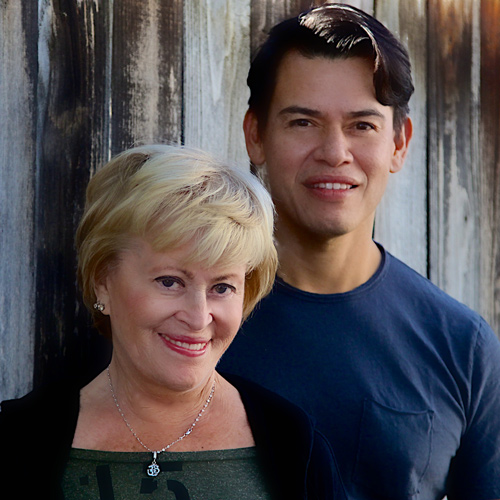“The things that go wrong in your life have a lot of potential to become a part of your gift to the world.” – Krista Tippett
If the toughest battles are given to the strongest people, Mari Winsor is living proof.
Winsor is a fitness expert and icon in the world of pilates. She is widely credited for popularizing the practice. She opened her first studio in Los Angeles in 1990 with a signature, innovative teaching sequence based on the teachings of Joseph Pilates.

With the combination of her unique charisma and natural teaching abilities, it wasn’t long before celebrities and high-profile clients, like Miley Cyrus and Drew Barrymore, began coming to classes regularly to get toned, shaped and chiseled for the cameras. In 2003, she whipped millions of Americans into shape with her Winsor Pilates workout videos which sold over 50 million programs.
Today, she’s after a whole new clientele – those diagnosed with a condition she recently developed herself.
“One of my friends called me the Stephen Hawking of Pilates” Winsor joked in an exclusive interview with ConnectWithLife.com.
Two years ago, Winsor was diagnosed with ALS, or Lou Gehrig’s Disease – the irreversible neurological condition that attacks the nerves responsible for muscle control. Over time, patients lose ability to move their body. This was grave news for someone who built a household name for herself in the world of fitness and movement.
“Well, first my thumbs stopped moving,” said Winsor. “Doctors said it was carpel tunnel. I went with that for a minute until they tried to schedule surgery and then something in me said this is not carpel tunnel, because every time I get stressed out it would get worse.”
Believing the problem was coming from her neck, Winsor got an MRI which led her doctor to suggest neck surgery. She decided to do the procedure. After a long and stressful recovery, her condition got worse. At their wits end, doctors recommended yet another surgery—this time on her elbow. Rather than opting for another dose of general anesthetic, Winsor wisely went to her neurologist for a second opinion. This time she was sent to get an extremely painful nerve test: an ENG.
But by this time, the writing was on the wall. “So at the end of that test the doctor told me I had Lou Gehrig’s disease. And, uh…” Winsor said, with a long pause to compose herself. “I didn’t quite know what to do with that information. I felt at that time like I was trapped. I felt like my body betrayed me and I didn’t know what to do.”
Even though there is no cure for ALS, there are certain things patients can do to make the symptoms slightly more bearable. And Luckily, Winsor happened to have the perfect background for creating some ease in the pain.
“When I got diagnosed I was sitting there with this Russian guy and I said, ‘What can I do? What can I do?’ He said ‘well, I really don’t know, there’s no cure. We’re working on treatments at this time.’ So I said ‘Well what can I do physically?’ He said well, ‘Pilates is good. Do you have a studio you can go to?’ And I said ‘Why don’t you google me?’ I made him google me like that.”

Winsor told us her story in an inspiringly cheerful countenance showing that though her muscles might be degenerating, her attitude couldn’t be touched.
“I wasn’t gonna let something like this stop me.” Winsor said. “So, with that in mind and with the love around me, I was encouraged to still teach even though my voice is a little funny and what not, I really wanted to.”
With a lot of support around her, Winsor began working on herself and others with ALS. Her business partner, long time instructor at Winsor Pilates and friend, Saul Choza has taken over the practice since her diagnosis. The two have opened a new location in Santa Monica to cater to pilates enthusiasts and those suffering with ALS. Every detail was taken into account to cater to their new clients needs—It’s on the ground floor making it easily accessible. Choza and Winsor have great plans for the future. For starters, they are hoping to partner with hospitals to offer rehabilitation to newly diagnosed patients. Instead of seeing an end, Winsor is creating a new reality for a new group of people, for whom her skills can be potentially life changing.
Winsor currently works with ALS patients to maintain strength, the body’s movement and range of motion. Still attending dance classes and other fitness classes herself, she’s a walking testament to the power of pilates and a positive attitude.
“My message is to never give up.… never stop moving and not to focus on what you cannot do but focus on what you can do. And go from there.”
The new studio, Winsor Choza Pilates will officially open in April.
— With reporting by Raha Lewis






I do Pilates on a regular basis. I favor Windsor Pilates because of the clear instructionsthe patience and encouragement in her voice, and of course the awesome physical results. When I heard about her having ALSO, I was shocked at first, but then I thought to my self, if any body can not only DEAL with ALS, but even CONCUR ALS, it’s Marie Windsor. Thank you, Marie Windsor, for teaching us–once again–about how to master those huge, unexpected challenges that come our way.
Hello,
This infection gave me symptoms of ALS. I’d like to share information I learned during my workplace’s outbreak of an airborne infectious disease that can cause malignancies, precancerous conditions, rheumatological diseases, connective tissue diseases, heart disease, autoimmune symptoms, inflammation in any organ/tissue, seizures, migraines, mood swings, hallucinations, etc. and is often undiagnosed/misdiagnosed in immunocompetent people. 80-90 % of people in some areas have been infected, and it can lay dormant for up to 40 years in the lungs and/or adrenals.
My coworkers and I, all immunocompetent, got Disseminated Histoplasmosis in Dallas-Fort Worth from roosting bats, the most numerous non-human mammal in the U.S., that shed the fungus in their feces. The doctors said we couldn’t possibly have it, since we all had intact immune systems. The doctors were wrong. Healthy people can get it, too, with widely varying symptoms. And we did not develop immunity over time, we’d get better and then progressively worse, relapsing periodically and concurrently every year.
More than 100 outbreaks have occurred in the U.S. since 1938, and those are just the ones that were figured out, since people go to different doctors. One outbreak was over 100,000 victims in Indianapolis.
It’s known to cause hematological malignancies, and some doctors claim their leukemia patients go into remission when given antifungal. My friend in another state who died from lupus lived across the street from a bat colony. An acquaintance with alopecia universalis and whose mother had degenerative brain disorder has bat houses on their property.
There’s too much smoke for there not to be at least a little fire.
Researchers claim the subacute type is more common than believed. It’s known to at least “mimic” autoimmune diseases and cancer and known to give false-positives in PET scans. But no one diagnosed with an autoimmune disease or cancer is screened for it. In fact, at least one NIH paper states explicitly that all patients diagnosed with sarcoidosis be tested for it, but most, if not all, are not. Other doctors are claiming sarcoidosis IS disseminated histoplasmosis.
What if this infection, that made me and my coworkers so ill, isn’t rare in immunocompetent people? What if just the diagnosis is rare, since most doctors apparently ignore it? Especially since online documents erroneously state it’s not zoonotic.
This pathogen parasitizes the reticuloendothelial system/invades macrophages, can infect and affect the lymphatic system and all tissues/organs, causes inflammation, granulomas, and idiopathic (unknown cause) diseases and conditions, including hematological malignancies, autoimmune symptoms, myelitis, myositis, vasculitis, panniculitis, dysplasia, hyperplasia, etc. It causes hypervascularization, calcifications, sclerosis, fibrosis, necrosis, eosinophilia, leukopenia, anemia, neutrophilia, pancytopenia, thrombocytopenia, hypoglycemia, cysts, abscesses, polyps, stenosis, perforations, GI problems, hepatitis, focal neurologic deficits, etc.
Many diseases it might cause are comorbid with other diseases it might cause, for example depression/anxiety/MS linked to Crohn’s.
The fungus is an Oxygenale and therefore consumes collagen. It’s known to cause connective tissue diseases (Myxomatous degeneration?), rheumatological conditions, seizures, and mental illness. Fungal hyphae carry an electrical charge and align under a current. It causes RNA/DNA damage. It’s known to cause delusions, wild mood swings (pseudobulbar affect?), and hallucinations. It’s most potent in female lactating bats, because the fungus likes sugar (lactose) and nitrogen (amino acids, protein, neurotransmitters?). What about female lactating humans…postpartum psychosis (and don’t some of these poor women also have trouble swallowing)? The bats give birth late spring/summer, and I noticed suicide rates spike in late spring/early summer. It’s known to cause retinal detachment, and retinal detachments are known to peak around June-July/in hot weather. A map of mental distress and some diseases appear to almost perfectly overlay a map of Histoplasmosis. Johns Hopkins linked autism to an immune response in the womb. Alzheimer’s was linked to hypoglycemia, which can be caused by chronic CNS histoplasmosis. The bats eat moths, which are attracted to blue and white city lights that simulate the moon the moths use to navigate. Bats feed up to 500 feet in the air and six miles away in any direction from their roost, but not when it’s raining or when the temperature is less than approximately 56° F.
I believe the “side effects” of Haldol (leukopenia and MS symptoms) might not always be side effects but just more symptoms of Disseminated Histoplasmosis, since it causes leukopenia and MS symptoms. What about the unknown reason why beta receptor blockers cause tardive dyskinesia? The tinnitus, photophobia, psychosis “caused” by Cipro? Hypersexuality and leukemia “caused” by Abilify? Humira linked to lymphoma, leukemia and melanoma in children? Disseminated Histoplasmosis is known to cause enteropathy, so could some people thought to have nonsteroidal anti-inflammatory drug enteropathy have it and taking NSAIDs for the pain/inflammation it causes, and the NSAIDs aren’t the actual culprit?
From my experience, I learned that NO doctor, at least in DFW, will suspect subacute and/or progressive disseminated histoplasmosis in immunocompetent people. Some doctors, at least the ones I went to, will actually REFUSE to test for it, even when told someone and their coworkers have all the symptoms and spend a lot of time in a building with bats in the ceiling. Victims will be accused of hypochondriasis. In fact, the first doctor to diagnose me was a pulmonologist, and the only reason he examined me was to try to prove that I didn’t have it, when I really did. No doctor I went to realized bats carry the fungus. And NO doctor I went to in DFW, even infectious disease “experts,” understand the DISSEMINATED form, just the pulmonary form, and the only test that will be done by many doctors before they diagnose people as NOT having it is an X-ray, even though at least 40-70% of victims will have NO sign of it on a lung X-ray. It OFTEN gives false-negatives in lab tests (some people are correctly diagnosed only during an autopsy after obtaining negative test results) and cultures may not show growth until after 12 weeks of incubation (but some labs report results after 2 weeks).
One disease of unknown cause that could be caused by Disseminated Histoplasmosis: I suspect, based on my and my coworker’s symptoms (during our “rare” infectious disease outbreak) and my research, that interstitial cystitis and its comorbid conditions can be caused by disseminated histoplasmosis, which causes inflammation throughout the body, causes “autoimmune” symptoms, and is not as rare as believed. I read that “interstitial cystitis (IC) is a chronic inflammatory condition of the submucosal and muscular layers of the bladder, and the cause is currently unknown. Some people with IC have been diagnosed with other conditions such as irritable bowel syndrome (IBS), fibromyalgia, chronic fatigue syndrome, allergies, and Sjogren’s syndrome, which raises the possibility that interstitial cystitis may be caused by mechanisms that cause these other conditions. In addition, men with IC are frequently diagnosed as having chronic nonbacterial prostatitis, and there is an extensive overlap of symptoms and treatment between the two conditions, leading researchers to posit that the conditions may share the same etiology and pathology.” Sounds like Disseminated Histoplasmosis, doesn’t it?
My coworkers and I were always most ill around April/May/June, presumably since the Mexican Free-tail bats gave birth in Texas during May, and fall/Thanksgiving to December, for some unknown reason (maybe migrating bats from the north?). We had GI problems, liver problems, weird rashes (erythema nodosum, erythema multiforme, erythema annulare, etc.), plantar fasciitis, etc., and I had swollen lymph nodes, hives, lesions, abdominal aura, and started getting migraines and plantar fasciitis in the building, and I haven’t had them since I left. It gave me temporary fecal incontinence, seizures, dark blood from my intestines, tinnitus, nystagmus, benign paroxysmal positional vertigo, what felt like burning skin, various aches and pains (some felt like pin pricks and pinches), tingling, tremors, “explosions” like fireworks in my head while sleeping, temporary blindness, and chronic spontaneous “orgasms”/convulsions. Suddenly I was allergic to pears (latex fruit allergy?). I had insomnia (presumably from the fungus acidifying the blood, releasing adrenaline) and parasomnias. I suddenly had symptoms of several inflammatory/autoimmune diseases, including Fibromyalgia, Sarcoidosis, ALS, MS, Sjogren’s syndrome, etc. that have disappeared since leaving the area and taking nothing but Itraconazole antifungal.
No one, including doctors (we all went to different ones), could figure out what was wrong with us, and I was being killed by my doctor, who mistakenly refused to believe I had it and gave me progressively higher and higher doses of Prednisone (at least 2 years after I already had Disseminated Histoplasmosis) after a positive ANA titer, until I miraculously remembered that a visiting man once told my elementary school class that bats CARRY histoplasmosis….so much of it that they evolved to deal with the photophobia and tinnitus it causes by hunting at night by echolocation. There’s a lot more. I wrote a book about my experience with Disseminated Histoplasmosis called “Batsh#t Crazy,” because bats shed the fungus in their feces and it causes delusions and hallucinations, I suspect by the sclerotia it can form emitting hallucinogens (like psilocybin and dimethyltryptamine) along with inflammation in the CNS. (Schizophrenics have 2X of a chemical associated with yeast, part of the fungal life cycle.)
Thank you for your time,
Susan McIntyre